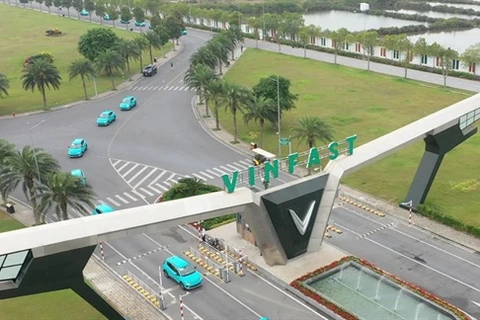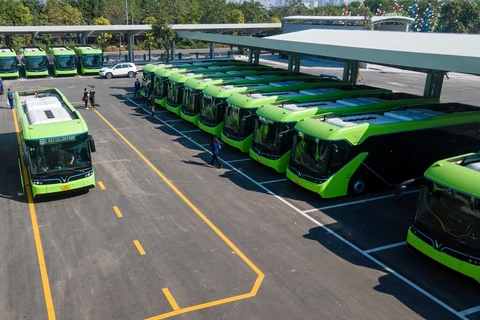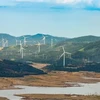 Using electric equipment helps increase productivity at seaports by about 10-20%, and significantly decrease operating costs. (Photo: VietnamPlus)
Using electric equipment helps increase productivity at seaports by about 10-20%, and significantly decrease operating costs. (Photo: VietnamPlus) Hanoi (VNA) – The transportation sector is speeding up restructuring in the direction of road transport and increasing environmentally friendly maritime, inland waterway and rail transport.
To fulfil Vietnam’s commitment to net-zero emissions by 2050 at the 26th United Nations Climate Change Conference of the Parties (COP26), the transportation sector will give priority to intensifying “greening" efforts across domains. It will focus on developing science and technology application-based multimodal transportation and logistics services.
Roadmap for “greening” transportation sector
In the global trend of integration, the maritime industry has been undergoing a transformation toward "Green" technology following a model of balance between environmental fluctuations and economic development demands.
In response, the Vietnam Maritime Administration (VMA) has announced foundational standards regarding the "green port" criteria encouraging businesses to develop suitable transition plans, as well as foster a new mindset in port operation and management.
To be recognised as a "green facility," ports must meet many criteria, including the use of renewable energy sources such as wind and solar power, and alternative fuels like liquefied natural gas (NLG), hydrogen, and ammonia.
Ports are also encouraged to use energy-efficient equipment and technologies, optimise operation and exploitation chains, and apply online payment systems and transition to electronic documentation.
The Tan Cang Cat Lai Port and the Tan Cang-Cai Mep International Port in Ho Chi Minh City were recognised by APEC Port Services Network as green ports in 2018 and 2021, respectively, because they met the criteria of environmental protection and clean energy use.
VMA Deputy General Director Hoang Hong Giang affirmed that a “green” seaport is a strategic trend in the world to control pollutants, use energy economically and effectively, prevent environmental incidents, and limit emissions of substances that cause greenhouse gas emissions and minimise the impact of climate change.
Many businesses have been actively developing smart seaports and aligning their strategies to develop “green” ports, which promote environmental protection and increase competitiveness.
A study shows that shipping is responsible for 3-4% of global greenhouse (GHG) emissions and is predicted to increase to 17% by 2050 if left unregulated.
According to a representative of the Saigon Newport Corporation (the owner of Tan Cang Cat Lai Port), the corporation has focused on replacing lifting equipment using diesel with electric equipment, helping save 1.5-2 million USD in fuel costs per year.
In the green energy transformation action programme, the Government requested HCM City and Hanoi to have the rate of “green” buses of at least 50% by 2030, and 100% by 2035.
A representative of the Hanoi Department of Transport said that the capital city has the most types of environmentally friendly public passenger transport, including CNG and electric buses, electric taxis, urban rail, two-wheeled electric vehicles and public bicycles.
However, the city still has 1,757 buses running on diesel fuel that need to be replaced with vehicles using clean energy.
Ho Lien Nam, Deputy General Director of Quy Nhon Port JSC said that Quy Nhon Port's capacity has been improved thanks to investment in port equipment.
Using electric equipment helps seaports increase productivity by about 10-20%, and significantly decrease operating costs, Nam said.
Addressing the 2023 Global Sustainable Transport Forum in China in late September, Minister of Transport Nguyen Van Thang affirmed that Vietnam considers environmentally sustainable transport development a focused priority.
Vietnam promotes transport restructuring in the direction of reducing road transport, and increasing environmentally friendly maritime, inland waterway, and railway transport. Other options on the green pathway include more efficient multimodal transport and logistics services, improving transport quality and reducing logistics costs./.






















